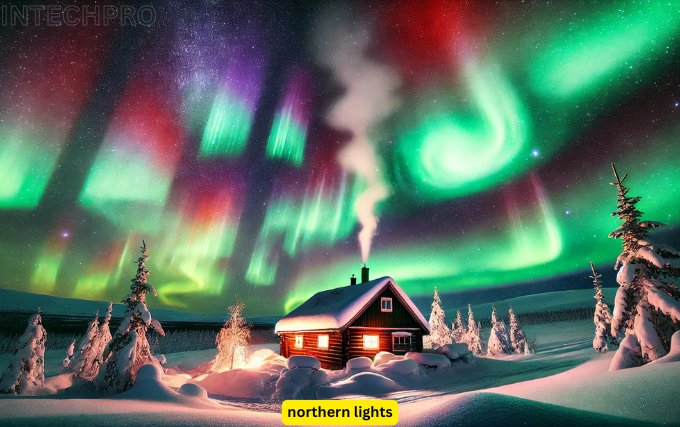Imagine standing under a night sky that suddenly comes alive with vibrant colors, swirling and dancing across the horizon. This mesmerizing display, known as the Northern Lights or Aurora Borealis, has fascinated humans for centuries. In this article, we will delve into the captivating phenomenon of the Northern Lights, exploring their origins, cultural significance, best viewing spots, and tips for witnessing this natural wonder.
What Are the Northern Lights?
The Northern Lights are a natural light display predominantly seen in high-latitude regions around the Arctic and Antarctic. These lights are the result of collisions between electrically charged particles from the sun and gases like oxygen and nitrogen in the Earth’s atmosphere. The energy released during these collisions produces the spectacular light show known as the aurora.
How Do They Form?
- Solar Winds: The process begins with solar winds, streams of charged particles emitted by the sun.
- Magnetic Field Interaction: When these particles reach Earth, they interact with the planet’s magnetic field.
- Atmospheric Collisions: The charged particles collide with gases in the Earth’s atmosphere, such as oxygen and nitrogen, causing them to emit light.
Colors of the Aurora
- Green: The most common color, produced by oxygen molecules located about 60 miles above the Earth.
- Red: Rare and occurs at higher altitudes, over 150 miles, caused by high-altitude oxygen.
- Blue and Purple: Produced by nitrogen and are less common but equally stunning.
The Science Behind the Spectacle
To fully appreciate the Northern Lights, it helps to understand the science behind them. The sun constantly emits a stream of charged particles, known as the solar wind. When these particles reach Earth, they are drawn towards the poles by the planet’s magnetic field. As they collide with gases in the Earth’s atmosphere, they release energy in the form of light, creating the breathtaking auroras.
Solar Activity and Auroras
The intensity and frequency of the Northern Lights are influenced by the sun’s activity, particularly the solar cycle, which lasts about 11 years. During periods of high solar activity, known as solar maximum, auroras are more frequent and vibrant.
Cultural Significance of the Northern Lights
The Northern Lights have held significant cultural and spiritual meaning for many indigenous peoples and cultures across the globe. Here are a few notable examples:
Indigenous Beliefs
- Sámi Culture: The Sámi people of Northern Europe believed the lights were the souls of the departed or a result of the forces of nature in a playful mood.
- Inuit Legends: Many Inuit tribes in North America viewed the auroras as the spirits of animals or ancestors playing in the sky.
Mythology and Folklore
- Norse Mythology: In Norse mythology, the auroras were seen as reflections from the shields of the Valkyries, warrior maidens who guided fallen warriors to Valhalla.
- Finnish Folklore: The Finnish word for the Northern Lights, “revontulet,” translates to “fox fires,” stemming from a tale of a magical fox sweeping its tail across the snow, sending sparks into the sky.
Best Places to Witness the Northern Lights
Seeing the Northern Lights in person is a bucket-list experience for many. While they can occasionally be seen in lower latitudes during strong solar storms, the best places to witness them are within the Arctic Circle. Here are some top destinations:
Northern Europe
- Norway: Tromsø is one of the best places in the world to see the Northern Lights, thanks to its high latitude and clear skies.
- Sweden: Abisko National Park is renowned for its “Blue Hole,” a patch of sky that remains clear despite surrounding weather conditions.
- Finland: The Finnish Lapland offers numerous aurora-watching opportunities, with glass igloos providing a unique viewing experience.
North America
- Alaska, USA: Fairbanks is a popular destination for aurora hunters, with a high likelihood of sightings and several tour operators offering viewing excursions.
- Canada: The Yukon, Northwest Territories, and Nunavut provide excellent viewing opportunities, with many accessible from major cities like Whitehorse and Yellowknife.
Other Locations
- Iceland: Easily accessible from Europe and North America, Iceland offers spectacular aurora views, especially during winter months.
- Greenland: With minimal light pollution and vast open spaces, Greenland is a prime location for aurora spotting.
Tips for Aurora Watching
Witnessing the Northern Lights requires some planning and a bit of luck. Here are some tips to enhance your chances of seeing this natural wonder:
Plan Your Trip During Peak Times
- Season: The best time to see the Northern Lights is during the winter months, from late September to early April.
- Time of Night: Auroras are typically visible between 10 PM and 2 AM, with peak activity around midnight.
Check the Forecast
- Aurora Forecast: Websites and apps provide real-time aurora forecasts based on solar activity, helping you determine the best nights for viewing.
- Weather Conditions: Clear skies are essential for aurora viewing. Check local weather forecasts and be prepared to move to different locations if necessary.
Choose the Right Location
- Away from Light Pollution: Find a spot far from city lights to ensure the best visibility.
- High Altitude: Higher elevations often provide clearer skies and better viewing conditions.
Be Patient and Prepared
- Warm Clothing: Dress in layers and bring warm clothing, as aurora watching often involves long periods in cold environments.
- Photography Tips: Use a tripod, wide-angle lens, and long exposure settings to capture stunning images of the auroras.
The Impact of the Northern Lights on Modern Culture
Beyond their cultural and scientific significance, the Northern Lights continue to inspire and influence modern art, literature, and tourism. Artists capture their beauty in paintings and photographs, while writers weave them into stories and poems. The growing interest in aurora tourism boosts local economies and raises awareness about the importance of preserving these natural wonders.
Aurora in Art and Literature
- Visual Arts: Many contemporary artists are inspired by the auroras, creating stunning visual representations in various mediums.
- Literature: From ancient myths to modern novels, the Northern Lights have been a source of inspiration for writers around the world.
Aurora Tourism
- Economic Boost: Aurora tourism provides significant economic benefits to regions within the auroral zone, creating jobs and supporting local businesses.
- Environmental Awareness: Increased interest in the Northern Lights encourages environmental consciousness and efforts to combat light pollution.
Conclusion
The Northern Lights are a breathtaking natural phenomenon that captivates the hearts and minds of those fortunate enough to witness them. By understanding their origins, cultural significance, and the best ways to see them, you can fully appreciate the magic of the auroras. Whether you’re an avid traveler, a photography enthusiast, or simply someone who appreciates the wonders of nature, the Northern Lights offer an unforgettable experience that will leave you in awe of the beauty and complexity of our world.



Normally I do not read article on blogs, but I wish to say
that this write-up very forced me to check out and do so!
Your writing taste has been surprised me. Thank you, quite great article.